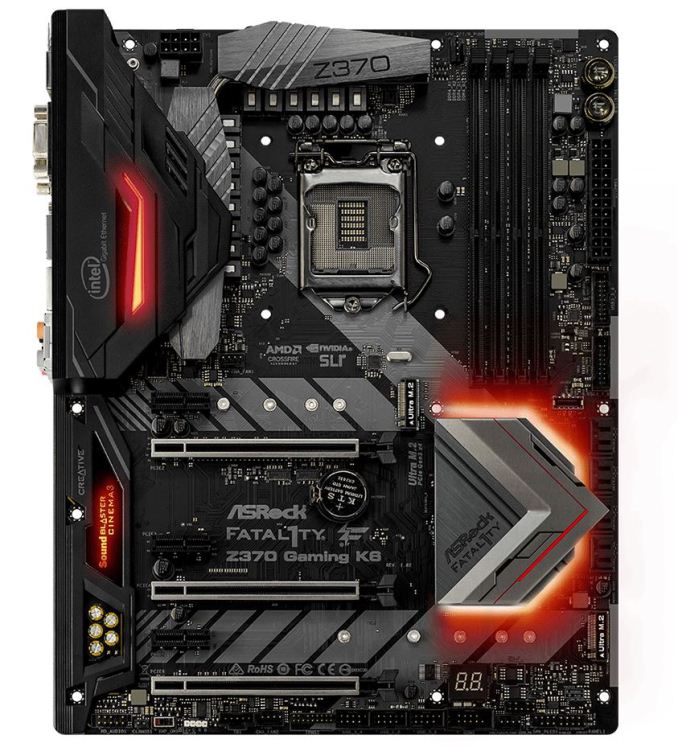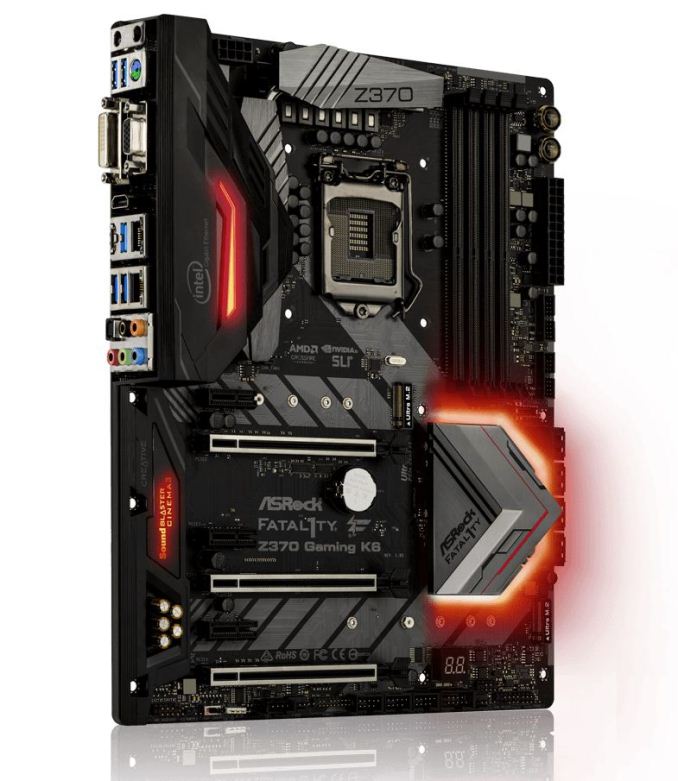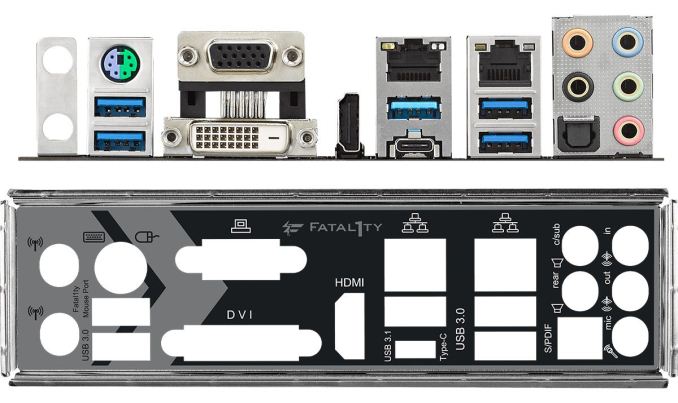Analyzing Z370 for Intel's 8th Generation Coffee Lake: A Quick Look at 50+ Motherboards
by Ian Cutress, Anton Shilov, Joe Shields & Gavin Bonshor on October 20, 2017 2:00 PM ESTASRock Z370 Gaming K6
The Gaming K6 is the second board in the Gaming lineup. The board is styled similarly but has fewer features when comparing it to the flagship, such as removing some of the premium features like 10-gigabit Ethernet.
The overall appearance of the board is nearly the same as its big brother. The differences worth mentioning is the power and reset buttons have moved from next to the debug LED at the bottom right to the top right-hand corner. The debug LED remains in the same location as well as the other RGB LEDs in the shrouds and chipset heatsink. Additional strips can be added using the RGB header located on the bottom of the board.
Memory capacity and supported speeds are the same as the high-end model, at 64GB and DDR4-4333 respectively. There are three reinforced full-length PCIe slots, capable of running at x16 single, x8/x8 dual, and x8/x4/x4 when all are populated. To accompany this are three open-ended PCIe x1 slots, supporting larger cards but only at x1 bandwidth. This lane configuration allows support for 2-way SLI and 3-Way Crossfire.
The Gaming K6 breaks the regular Z370 mold and gives users eight SATA ports, six from the chipset and two additional ports from an ASM1061 controller. Two M.2 slots are on the K6 with the top one supporting 80mm drives and the other one nearer the chipset supporting up to 110mm. The first M.2 slot shares lanes with SATA 0/1 ports while the second shared with SATA 4/5 ports when SATA drives are connected.
Audio is handled by the Realtek ALC1220 codec and offers the same features as the flagship Pro Gaming i7 using Nichicon Gold series audio caps and the same NE5532 headset amplifier. Sound shaping is handled by the Creative Sound Blaster Cinema 3 software. Networking responsibilities are handed off to two Intel NICs, an I219-V and I211-AT. Though wireless networking isn’t included, there is an M.2 E-Key slot in the back panel if needed.
USB connectivity is similar with the K6 offering a front panel USB 3.1 (10 Gbps) Type-C port as well as Type-C and Type-A ports on the back panel using an ASMedia chipset. Four USB 3.1 (5 Gbps) ports are on the rear panel, with two additional headers on board. Six USB 2.0 ports via three headers are also supported. The rear panel IO also has a combination PS/2 port, and uses D-Sub, DVI-D and HDMI video outputs.













83 Comments
View All Comments
weevilone - Wednesday, October 25, 2017 - link
Notable that though the new boards are often very similar to their Z270 predecessors, Asus has dropped Thunderbolt 3 support from the Maximus X Hero board.masouth - Thursday, October 26, 2017 - link
ASUS ROG Z370 Maximus X Hero"....new metallic heat sinks that are an upgrade over the plastic heatsinks found on the Z270 version"
Please excuse my ignorance because I didn't own a ROG Z270 mb but...plastic HEAT SINKS? Not shrouds or decoration over a heat sink but the actual heat sinks themselves? That's either wrong, they performed their job pretty poorly, or plastic resins have advanced a lot farther in thermal conductivity (and cost for such) than I realized.
flowrush - Sunday, November 19, 2017 - link
"The other main distinguishable feature is the inclusion of integrated 802.11ac Wi-Fi with an antenna (that can only be described as a shark fin) found on the F."The above is incorrect in the article. The integrated Wi-Fi module with antenna is found on the E not the F.
Coldgame - Saturday, November 25, 2017 - link
I'm looking to build a rig with the Z370 Gaming ITX/ac, a GTX-1070 card and an Apple Thunderbolt Display.The review states:
"The key difference in the support between the two boards is going to be the Thunderbolt 3 port on the Gaming-ITX. This port supports video outputs..."
So, can anyone confirm or deny that video generated by the GTX-1070 can be output through the onboard Thunderbolt 3 port?
hanselltc - Sunday, December 3, 2017 - link
Looking forward to low-middle end mITX choices from this platform. It'll probably be paired with a 8100/8300 and be my secondary machine.Roen - Sunday, February 4, 2018 - link
Where are the 10 Gbps ports on the back? They all look like 5 Gbps ports, even the Type C.rbarak - Wednesday, February 21, 2018 - link
Is anyone using the Z370-P on Linux with two screens?I built a new machine based on the Z370-P, and both the DVI and the HDMI connected screens show the same image, and the RHEL7 setup/displays show only one Unknown Display.
I follwed the advice on stackexchange, and added this line:
$ grep GRUB_CMDLINE_LINE_DEFAULT /etc/default/grub
GRUB_CMDLINE_LINE_DEFAULT="i915.alpha_support=1"
Then I did:
sudo grub2-mkconfig -o "$(readlink /etc/grub2.conf)"
And rebooted, but still, the two displays are not shown.
dromoxen - Wednesday, May 9, 2018 - link
Shocked to see that both the Asrock mitx boards are "szie=ATX" .. LOLThe addition of Tunderbolt sure seems to add a hefty premium £120 vs £160 , luckily I can do without.
Kroebo - Sunday, October 7, 2018 - link
Sadly, I discovered that the ZUG Gaming PLUS doesn't support SLI.trag - Tuesday, January 15, 2019 - link
On the ASrock Z370M Pro4 the M.2 slot information is backwards. Both slots support NVME. One slot also supports SATA. As written, "The first M.2 slot is SATA only while the second supports PCIe." it seems to say that one slot is SATA only and the other slot is PCIe (NVME) only.